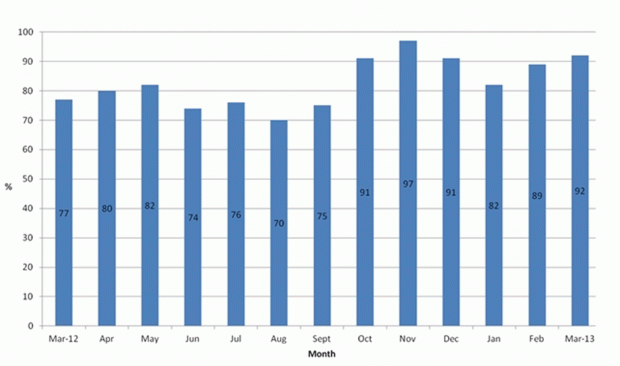Dairy cow lameness overview
Lameness can adversely affect several areas such as milk production, fertility and feeding behaviour. On average each case of lameness costs £323 on a typical farm (see Table 1). Using the DairyCo mobility scoring system lameness is defined as cows scoring 2 or 3.
| Disease | Cost (£) |
|---|---|
| Sole ulcer | 519 |
| White line disease | 300 |
| Digital dermatitis | 76 |
Research carried out on 57 Northern Ireland dairy farms by AFBI (Hillsborough) showed that on average 33% of cows in the herd were lame (range 1.5-74.7%). These lameness levels were similar to those found in England and Wales (37%) and other EU countries. Due to the range in lameness levels between farms, this research suggests that dairy cow mobility could be improved through the adoption of specific practical strategies, highlighted within this section.
Research into lameness
Extensive research has been carried out in both NI and UK, please see below some key scientific reports of interest.
Early detection through mobility scoring and treatment of lame cows (University of Bristol).
- Strategies to reduce lameness in NI dairy farms, AFBI
- Treatment and prevention of foot lameness in cattle
Practical information to improve cow mobility
This section provides practical information into areas such as mobility scoring, foot trimming, footbathing and housing.
Mobility scoring
What is mobility scoring. Mobility scoring is a system whereby cows are scored on a scale of 0-3 based on their mobility, with 0 being good and 3 being a severely lame cow.
Video of mobility scoring
Mobility scoring results of the future herd
Mobility index is the percentage of cows as an overall total of the herd not lame, that is, cows with mobility scores 0 or 1.
The Future herd is mobility scored on a monthly basis, with lame cows (mobility score 2 or 3) scheduled for treatment as soon as possible. The annual target (average) for mobility index within the Future herd is 80%.

Foot trimming
Foot trimming of dairy cows
Regular and routine foot trimming is important to maintain even and appropriate foot balance. It is important to note that all foot trimming should be carried out by an appropriately trained person. Research shows that early and effective treatment of lame cows (within 48 hours) works to reduce lameness in a herd.
Video demonstrating the five step Dutch method (Peter Orpin & Nick Bell)
Video demonstrating the treatment of sole ulcers
CAFRE foot trimming report
This is a simple record sheet which enables you to record the various foot diseases found within your herd. As a result the most common foot problems occurring on your farm can be identified and discussed with your vet, leading to possible changes being made at a farm level to reduce them. Irrespective if foot trimming is carried out by yourself, vet or contractor a record ideally should be kept.
Examples of roll over and vertical lifting foot trimming crushes
Examples shown of foot trimming crushes below are for illustration purposes only, the list is not exhaustive and no criticism is implied of products which have been omitted.
Roll over crush
Vehicle lifting crush
CAFRE footbath calibration tool
(Please log in via DARD online services, then go to Technical notes-new CAFRE dairy unit)
A survey recently carried out by AFBI indicated that a large proportion of farmers who use footbaths, were unaware of the concentration rates they used. Based on this CAFRE have developed a footbath calibration tool for dairy farmers. The calibration tool is a guide in determining the volume of water in the footbath and quantity of footbathing product required.
